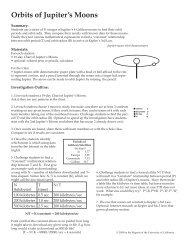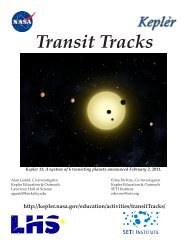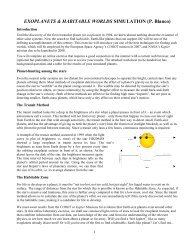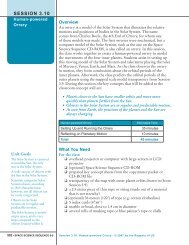POSTER ABSTRACTSP1023. POSTER SESSION IIZODIACAL DUST BANDS OBSERVED IN THE KEPLER BACKGROUND . J. E. Van Cleve *1 , W. T.Reach 2 , F. C. Witteborn 3 , D. Caldwell 1 , B. Clarke 1 , W. Borucki 4 , and J. M. Jenkins 1*jeffrey.vancleve@nasa.gov, 1 SETI Institute/<strong>NASA</strong>-Ames Research Center, MS 244-30, Moffett Field, CA94035, 2 USRA/SOFIA, 3 Orbital Sciences Corp., 4 <strong>NASA</strong>-Ames Research CenterIntroduction: <strong>Kepler</strong> measures the brightness ofthe background on each Long Cadence (LC) using adedicated array of background pixels on each channel.This background is the sum of zodiacal light and unresolvedstars in roughly equal proportion. Since theunresolved stellar contribution is unchanging in <strong>Kepler</strong>’sfixed field of view (FOV), the time-varyingcomponent of these background observations is due tothe zodiacal light. Within this FOV, <strong>Kepler</strong> offers acombination of spatial and temporal resolution, precision,and data continuity not matched by any othersingle instrument for the study of the threedimensionalstructure of zodiacal light. <strong>Kepler</strong> thuscomplements the all-sky maps of infrared survey missionssuch as IRAS, COBE, and WISE.Detection and Imaging of Events: Early <strong>Kepler</strong>operations showed transient background phenomenalasting at most a few minutes, which were attributed tosunlight scattered from debris spalled off <strong>Kepler</strong> bymicrometeoroids [1]. In the course of that earlierstudy, we also found a few transients on time scales of2-48 hrs, with amplitude of a few percent of the largescalebackground in the <strong>Kepler</strong> FOV, which move ascoherent structures across the focal plane (Figures 1and 2), which we interpreted as scattered light fromdust particles of cometary or asteroidal origin in ourSolar System.Here we report a more thorough study of theseslow events in the first two years of <strong>Kepler</strong> data, usinga detection filter which is better matched spatially andtemporally to these slower events than the one used forthe debris events. We construct event images by subtractingbackground maps from times well-removedfrom the event from background maps based on pixelscollected during the detected event. We then relate theheliocentric longitude and orientation of the structuresobserved at a given point in <strong>Kepler</strong>’s earth-trailingorbit to those expected from known comet and asteroiddust trails [2, 3, 4], compare the low spatial and temporalfrequency component of the observed zodiacal lightto the predictions of the three dimensional model ofReach [4], and examine the year-to-year reproducibilityof events at the same ecliptic longitude. Based onthe early results shown in Witteborn [1], we expect tobe able to detect events as faint as 0.5% of the largescalezodiacal brightness, with spatial resolution ofsmall as 0.25 degrees. An initial inspection of thebackground flux time series suggests 2 or 3 events perobserving quarter will be found.Figure 1: Early event image from LC #13395 of anelongated object that stayed in the focal plane forover 6 hours on MJD 55215. The image is 13.0x13.0degrees; flux units are e-/cadence per pixel. Themaximum on the scale corresponds to only 0.8% ofthe large-scale sky brightness.Figure 2: The elongated object as seen 6 hr later onLC #13407. It maintained about the same size andshape in all the intervening images, but slowlymoved upward in the field-of-view as one wouldexpect for an object, which <strong>Kepler</strong> passes “underneath”in the course of its earth-trailing heliocentricorbit. Image scale and flux units are the same as inFigure 1.Funding for this work is provided by the <strong>NASA</strong>Science Mission Directorate.References:[1] Witteborn F. C. et al. (2011) Proc. SPIE 8151[2] Nesvorny, D. et al. (2010) ApJ 713, 816. [3] Mainzer,A. et al. (2011) ApJ 731, 53. [4] Reach, W. T.(2010) Icarus 209, 848.2262011 <strong>Kepler</strong> Science Conference - <strong>NASA</strong> Ames Research Center
POSTER ABSTRACTSP1024. POSTER SESSION IIUNDERSTANDING QUASAR VARIABILITY THROUGH KEPLER. A. E. Wehrle 1 , S. C. Unwin 2 , P. J. Wiita3 , and D. Silano 3 ,1 Space Science Institute, 4750 Walnut Street, Suite 205, Boulder, CO 80301,awehrle@spacescience.org,2 JPL, Mail Code 301-170S, 4800 Oak Grove Drive, Pasadena, CA 91101,Stephen.c.unwin@jpl.nasa.gov, 3 The College of New Jersey, Department of Physics, P.O. Box 7718, Ewing, NJ08628, wiitap@tcnj.edu, silano2@tcnj.edu.We are monitoring four flat spectrum radio quasars(blazars) and one powerful radio galaxy, Cygnus A, tosearch for variability on timescales comparable to thelight crossing time of the accretion disk around thecentral supermassive black hole and the base of therelativistic jet. We want to see if some optical variabilityin quasars is due to a bright feature in the accretiondisk as it approaches the last stable orbit, or if it is dueto inhomogeneities in the jet, possibly in a helicalstructure. When the quasars are in quiescent, faintstates, a quasi-periodic light curve indicates an accretiondisk origin, and provides a dynamical means ofmeasuring a lower limit to the mass of the supermassiveblack hole which may be compared to those derivedby other methods, such as the shape of X-ray ironK$\alpha$ lines and stellar velocity dispersions. Whenthe quasars are in bright states, then long-lived quasiperiodicoscillations (QPOs) are very probably fromhelical features in the jets, but if several differentshort-lived QPOs are seen in one quasar, then theemission is probably coming from turbulence behind ashock. If during a faint state, instead of QPOs, we detectaperiodic variations, including high and lowbreaks in the power spectrum density (PSD), then wemay obtain the physical scales of the inner and outeredges of accretion disks and hence the BH mass. Aperiodicvariations during a high state, with breaks in thePSD, could yield the smallest and largest physicalscales corresponding to light travel times, modulo theDoppler factor, in the relativistic jet.<strong>Kepler</strong> is ideally suited to the necessary measurementsby delivering highly stable photometry continuouslyon timescales from minutes to days. The principalchallenge of our <strong>Kepler</strong> data analysis is that the automaticpipeline removal of day-to-week-scale drifts alsoremoves real astrophysical brightness variations. Wewill present preliminary results on short timescalevariations.2011 <strong>Kepler</strong> Science Conference - <strong>NASA</strong> Ames Research Center 227











